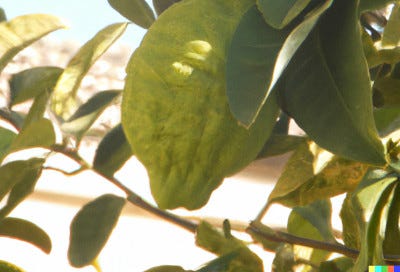As I’ve noted previously, even in North America, perfectly kosher and acceptable esrogim have - until recent years at least - been available in the $60 range. And yet it’s common for people - particularly members of the low-income kollel/yeshiva population - to spend $200 or $300 on an esrog. And that’s without this year’s extra costs due to shipping problems, runaway inflation, and the end of shemita.
Given that pre-war communities rarely had access to more than a few sets per shul - and never more than one per household - it’s notable that those same kollel/yeshiva families generally insist on purchasing sets for all the males in the family (those below bar mitzva-age in particular).
How did this happen? Part of the “blame” can perhaps be attributed to the position of the Rabbi A. Y. Karelitz (the Chazon Ish) regarding grafted esrogim (מורכבים - see his notes to Kelayim 3:7). While nearly all mainstream poskim agree that one may not use a esrog grown from the branch of a tree that had, itself, been grafted, esrogim grown on trees that themselves grew from seeds whose origins might have included grafting are permitted. The Chazon Ish encouraged us to reject even “second-generation” grafting.
There would seem to be problems with this:
As some poskim point out, it’s simply not possible to be sure that, 2,000 years back, the ancestors of any given tree anywhere in the world hadn’t been grafted. After all, we know from Chazal that grafting was a common practice in the ancient world. This might be the background behind something a talmid chochom once told me that he’d heard from close relatives who owned esrog orchards in Israel: “there’s no such thing as a בלתי מורכב esrog…”
Many (all?) esrogim currently sold as “Chazon Ish” are apparently the products of vines from the original “Chazon Ish” tree that were grafted onto existing rootstock. This would seem to defeat the purpose, as subsequent fruits would lack the desired “pure” lineage.
The demand for a relatively scarce commodity - esrogim sold by vendors who claim their products are uniquely graft-free - predictably pushes prices up.
Given all that, what drives so many families to line up each year to spend $1,000+ of funds they don’t have on esrogim that don’t seem to be halachicly remarkable? Similarly why, after performing the mitzva on their own sets, do so many insiders briefly lift sets belonging to others - as though those other sets are somehow more likely to get the job done? (Oddly, I’ve never seen those same individuals briefly putting on other people’s tefilin after shacharis, even though there’s far more that can go invisibly wrong with tefilin than with esrogim - and the ideal of הידור applies to both equally.)
Perhaps it’s not the halachic position of the Chazon Ish that’s driving the consumer trend at all. Instead, it could actually be inspired by a well known anecdote where Rabbi Karelitz encouraged his friend Rabbi Michel Yehuda Lefkowitz to plant the seeds of an esrog grown from a particularly pristine tree. Reportedly, the hope was that Rabbi Lefkowitz would later derive an income from the fruits.
I don’t know whether today’s “Chazon Ish” esrogim are less likely to be the products of grafting than any others sold with a reliable hechsher. But it’s certainly not difficult to imagine the designation being successfully translated into a marketing tool.
What if You Never Get to Use Your Own Esrog?
Many people spend a great deal of time and money each year in their search for the perfect esrog. Sure, we’re supposed to seek hiddurim in our four minim, but is it so obvious what those hiddurim actually are?
For years I’ve wondered if there’s any benefit in all the effort for those of us who can’t necessarily tell the difference between esrogim costing $100 and $300. (And after speaking with many people in the industry, I’m not completely convinced there actually are are always important differences.) Does just spending the money improve the quality of the mitzva?
But, a while back, I was thinking about this mishna in the fourth perek of Succah:
מצות לולב כיצד כל העם מוליכין את לולביהן להר הבית והחזנין מקבלין מידם וסודרין אותן על גג האיצטווה והזקנים מניחין את שלהם בלשכה ומלמדין אותן לומר כל מי שהגיע לולבי בידו הרי הוא לו במתנה ולמוחרת היו משכימין ובאים והחזנין מזרקין לפניהם
How was the mitzva of lulav performed (in the mikdash when the first day of yom tov fell on Shabbos)? Everyone would take their lulavim to the Temple Mount (before Shabbos) which the officials would take from their hands and arrange along the bleachers…(the officials) would teach everyone to say ‘I present my lulav as a gift to whoever receives it.’ The next morning, they would all come early and the officials would (randomly) throw (lulavim) before them.
While, as the mishna later makes clear, this procedure didn’t continue for long, it was the way Chazal would have preferred we do this mitzva (at least when the first day of yom tov fell on Shabbos, when carrying our lulavim to the mikdash was impossible).
Which means that we were expected to go to the trouble of purchasing and preparing our four minim with the full knowledge that we wouldn’t ever get to use them! After all, they would end up wherever the officials threw them that first morning.
Now, if you knew that you’d never get to use it yourself, would you spend as much money and energy getting it? For myself, at least, I’m not sure how I would answer that question.




